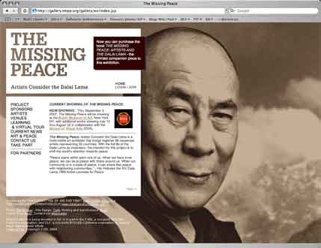
The Missing Peace: Artists Consider the Dalai Lama has opened in New York (March 2007), after successful runs in Los Angeles and Chicago, but for you newcomers to my blog, I wanted to remind you of the great online virtual tour of the exhibit, that I first described in August 2006. The tour will continue to be online until, well until long after the physical exhibit no longer exists. The idea behind having a virtual tour was twofold: first, to provide a way that people could see the artworks who otherwise will not be able to get to a real-world showing, and; second, to provide a preview the would be of value to those attending the exhibit.
In fact, it’s probably also a great “reminder” or those who’ve visited the show and forgotten the details of what they’ve seen.
Here’s a part of Darlene Markovich’s description of the opening in New York – The event began at 6:30. As we approached the museum just before 6:00, we were amazed to see a long line of people waiting in the cold and rain outside the doors to get in! The museum stopped counting at over 1,000 people so we don’t have the exact count of attendees. It was a big hit!
The event was very well organized and beautifully arranged – the food was excellent. Just for a moment, I wondered if their events always had such a draw, but museum staff told me that this crowd even exceeded their very large and well-attended anniversary event!
To us, since just over 50% of the exhibition was shown (4th and 5th floors and lower level) , it appeared to be a much smaller show; however, the installation is absolutely beautiful and the juxtaposition of ancient Himalayan art with TMP art is outstanding. To a person unfamiliar with the full exhibition, it was a major (sized) show. Most people commented that it was wonderful to see contemporary art at the RMA. The energy level was Himalayan-high. So much so, strangers would comment about the artworks to each other.
Sixteen TMP artists attended, and, as well, art critic and advisory board member Lilly Wei and art critic Kay Larson. It was a lot of fun to receive Christo and Jeanne-Claude as they raised quite a bit of excitement in the crowd.
What lies behind this online tour?
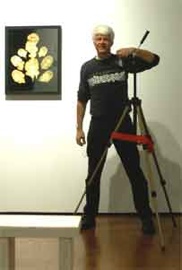 The day before The Missing Peace opened at the Fowler Museum at UCLA in June 2006, I was given two hours by myself in the galleries (with a guard), to take photos. I had gone to the trouble of bringing special lighting, but after some experimentation, I decided to take available-light photos – to get a more realistic color balance – with my camera on a tripod. Even this picture of me taking a picture of myself was taken with available light (in a mirror). It was a real rush to shoot 10,000 sq. ft. of exhibit space in two hours, getting photos from a hundred different angles, and getting them all sharp and clean.
The day before The Missing Peace opened at the Fowler Museum at UCLA in June 2006, I was given two hours by myself in the galleries (with a guard), to take photos. I had gone to the trouble of bringing special lighting, but after some experimentation, I decided to take available-light photos – to get a more realistic color balance – with my camera on a tripod. Even this picture of me taking a picture of myself was taken with available light (in a mirror). It was a real rush to shoot 10,000 sq. ft. of exhibit space in two hours, getting photos from a hundred different angles, and getting them all sharp and clean.
The virtual tour is constructed in Macromedia (Adobe) Flash. The Flash piece itself contains floor maps, and there are red buttons, blue squares and a few surprise mouse-overs. As you move the cursor over the red dots, the photos I took within the exhibit space fade in or fade out. Since just seeing the works in small photos gives you context but lacks detail, I did a second pass thru, adding the blue squares and for each blue square popping up an information panel that shows a single piece of art along with the artist’s description of that work.
This first screen shot below shows a floorplan with red dots and blue squares. This is only one of the two galleries in the Fowler venue:
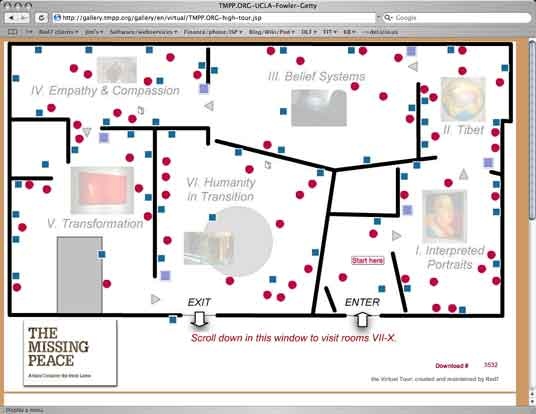
The screen shot below shows a single in-gallery photos popped up as the cursor passes over one of the red dots:
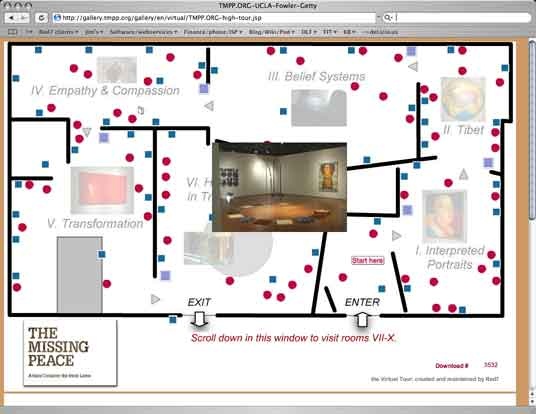
This last screen shot shows a detail panel with a photo of the work of art and the artist’s description. These are stored on a server and are not within the Flash piece itself. Thus, they’re changeable without having to re-work the Flash object. When a particular artist has a web site, there’s a special button that appears on this panel and the site visitor can go off and learn more about the artist’s life and work.
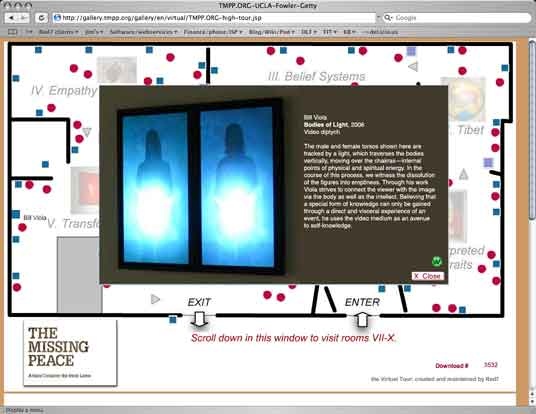
[posted with ecto]
Leave a Reply